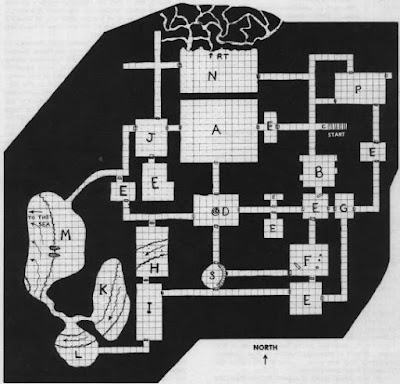In the comments to last week's post about The Official Advanced Dungeons & Dragons Coloring Album, an anonymous poster theorizes that "the map used here is identical to the one in the Holmes basic set intro adventure" to which commenter Frank replies that it's "not identical, but very close." In the interest of discussion, here's what the Holmes Basic Set map looks like:
If you look carefully at the two images, you'll see that Frank is indeed correct: the dungeons are very similar to one another but not quite identical. Even so, many of the most iconic features of the Holmes dungeon are still present in the Coloring Album version, like the sea caves at the bottom left and the rat warrens at the middle top. Zach Howard, over the excellent blog Zenopus Archives, has a useful post in which he looks at some of the similarities and differences between the two versions.
I'm fairly confident that the map appearing in the 1977 D&D Basic Set was created by Holmes himself, though I'm 100% certain of this fact. If so, that makes its reappearance in the Coloring Album, albeit in modified form, all the more fascinating to me. Why was it chosen? Was it because its compactness made it especially suitable for the pared down "D&D Lite" of the Coloring Album? Why not make an entirely new dungeon map? I suspect the answer is probably fairly mundane, but I can't help but wonder.



I wonder if one version one meant to be “player facing” and the other “GM’s eyes only”?
ReplyDeleteThe coloring book version really lends itself to all those jokes about "how did this monster get into this room, and more to the point, how does it plan to get out?" :)
ReplyDeleteFor some reason the sea cave and the underground river were incredibly evocative to me at the time. Such that the hand-drawn maps I made and still have around somewhere often included underground water features that I'm sure were inspired by that map.
ReplyDeleteDyson (of the Dyson's Dodecahedron blog and mapping fame) seems to have taken that lesson to heart. He uses a lot of water features in his work as well, often in quite elaborate three-dimensional layouts that stress verticality and the way water acts in caverns.
DeleteSame here.
DeleteThe presence of an underground waterway lends itself to answering the sort of “how did the monsters get here” questions that Dick McGee raised. It also explains how the residents of the dungeon got access to drinking water… But, perhaps most importantly, it was a giant “To Be Continued” sign, if the PCs were brave enough to attempt to follow the river.
Yea, many of my early dungeons had water features also. Hmm, it's notable that many of the early RuneQuest adventures had water features (Rainbow Mounds in Apple Lane, Snake Pipe Hollow) and that continued with later adventures also (Trollpak, Borderlands, Griffon Mountain, Duck Tower, and more).
Delete